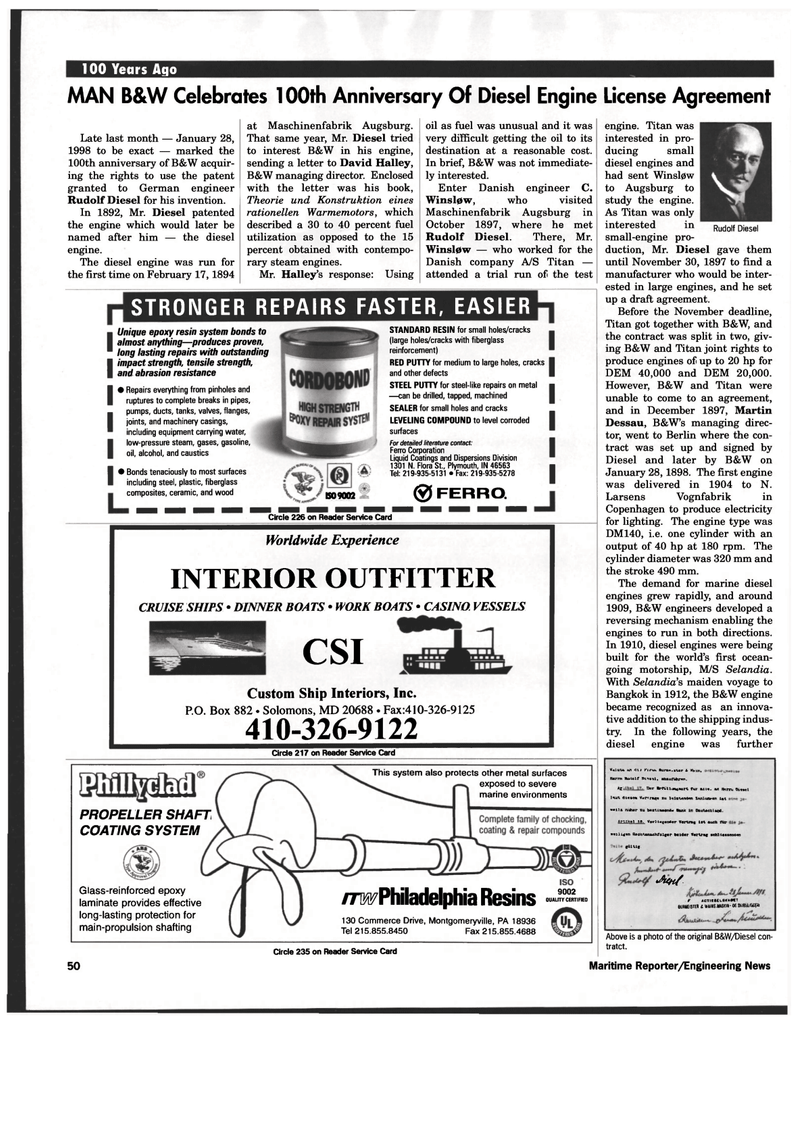
Page 54: of Maritime Reporter Magazine (February 1998)
Read this page in Pdf, Flash or Html5 edition of February 1998 Maritime Reporter Magazine
100 Years Ago
MAN B&W Celebrates 100th Anniversary Of Diesel Engine License Agreement
Late last month — January 28, 1998 to be exact — marked the 100th anniversary of B&W acquir- ing the rights to use the patent granted to German engineer
Rudolf Diesel for his invention.
In 1892, Mr. Diesel patented the engine which would later be named after him — the diesel engine.
The diesel engine was run for the first time on February 17, 1894 at Maschinenfabrik Augsburg.
That same year, Mr. Diesel tried to interest B&W in his engine, sending a letter to David Halley,
B&W managing director. Enclosed with the letter was his book,
Theorie und Konstruktion eines rationellen Warmemotors, which described a 30 to 40 percent fuel utilization as opposed to the 15 percent obtained with contempo- rary steam engines.
Mr. Halley's response: Using oil as fuel was unusual and it was very difficult getting the oil to its destination at a reasonable cost.
In brief, B&W was not immediate- ly interested.
Enter Danish engineer C.
Winsl0w, who visited
Maschinenfabrik Augsburg in
October 1897, where he met
Rudolf Diesel. There, Mr.
Winsl0w — who worked for the
Danish company A/S Titan — attended a trial run of the test
STRONGER REPAIRS FASTER, EASIER
Unique epoxy resin system bonds to almost anything—produces proven, long lasting repairs with outstanding impact strength, tensile strength, and abrasion resistance • Repairs everything from pinholes and ruptures to complete breaks in pipes, pumps, ducts, tanks, valves, flanges, joints, and machinery casings, including equipment carrying water, low-pressure steam, gases, gasoline, oil, alcohol, and caustics • Bonds tenaciously to most surfaces including steel, plastic, fiberglass composites, ceramic, and wood ISO9002
STANDARD RESIN for small holes/cracks (large holes/cracks with fiberglass reinforcement)
RED PUTTY for medium to large holes, cracks and other defects
STEEL PUTTY for steel-like repairs on metal —can be drilled, tapped, machined
SEALER for small holes and cracks
LEVELING COMPOUND to level corroded surfaces
For detailed literature contact:
Ferro Corporation
Liquid Coatings and Dispersions Division 1301 N. Flora St., Plymouth, IN 46563
Tel: 219-935-5131 • Fax: 219-935-5278 ® FERRO.
Circle 226 on Reader Service Card
Worldwide Experience
INTERIOR OUTFITTER
CRUISE SHIPS • DINNER BOATS • WORK BOATS • CASINO VESSELS
CSI
Custom Ship Interiors, Inc.
P.O. Box 882 • Solomons, MD 20688 • Fax:410-326-9125 410-326-9122
Circle 217 on Reader Service Card
This system also protects other metal surfaces exposed to severe marine environments
PROPELLER SHAFT
COATING SYSTEM
Glass-reinforced epoxy laminate provides effective long-lasting protection for main-propulsion shafting /^Philadelphia Resins 130 Commerce Drive, Montgomeryville, PA 18936
Tel 215.855.8450 Fax 215.855.4688 9002
QUALITY CERTIFIED
Rudolf Diesel
Circle 235 on Reader Service Card engine. Titan was interested in pro- ducing small diesel engines and had sent Winsl0w to Augsburg to study the engine.
As Titan was only interested in small-engine pro- duction, Mr. Diesel gave them until November 30, 1897 to find a manufacturer who would be inter- ested in large engines, and he set up a draft agreement.
Before the November deadline,
Titan got together with B&W, and the contract was split in two, giv- ing B&W and Titan joint rights to produce engines of up to 20 hp for
DEM 40,000 and DEM 20,000.
However, B&W and Titan were unable to come to an agreement, and in December 1897, Martin
Dessau, B&W's managing direc- tor, went to Berlin where the con- tract was set up and signed by
Diesel and later by B&W on
January 28, 1898. The first engine was delivered in 1904 to N.
Larsens Vognfabrik in
Copenhagen to produce electricity for lighting. The engine type was
DM140, i.e. one cylinder with an output of 40 hp at 180 rpm. The cylinder diameter was 320 mm and the stroke 490 mm.
The demand for marine diesel engines grew rapidly, and around 1909, B&W engineers developed a reversing mechanism enabling the engines to run in both directions.
In 1910, diesel engines were being built for the world's first ocean- going motorship, M/S Selandia.
With Selandia's maiden voyage to
Bangkok in 1912, the B&W engine became recognized as an innova- tive addition to the shipping indus- try. In the following years, the diesel engine was further
Valuta >l» j Bum*.st*r * *hm,
Harm Rutolf Dtnil, Bbzuftjhron. *r>*»*• BrrUUamtnorl f»r an (form Oi-jael l*ut 4wm V*r*ra«« su ltiat-orwUm Zwilum»«n iat «r»il» rviher zu bestinaendx Bank in Da utach taiga*
Artikol 18, Vorl itgonder Vertr** Ut «ucft fUr w*xU«<»n. Reohtwmchfoiger balder Vsrtrag eeMiesswiitw gUltig.
Juh/ a AcmaEtsKAWET 0URMEISTER 6. WMHSUHKM- 05 SMKfcfliGflU 50
Above is a photo of the original B&W/Diesel con- tratct.
Maritime Reporter/Engineering News

 53
53

 55
55
